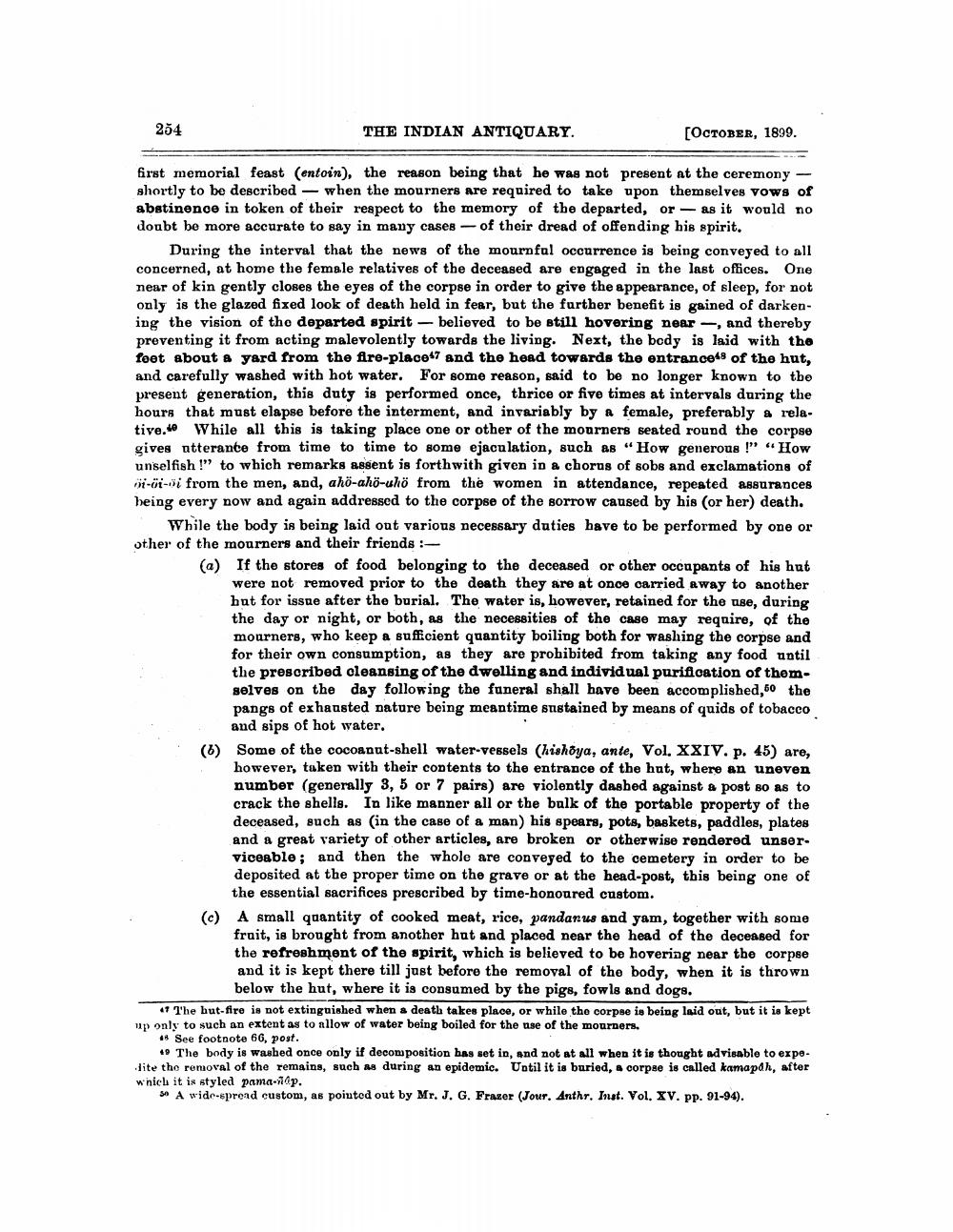________________
254
THE INDIAN ANTIQUARY.
[OCTOBER, 1899.
first memorial feast (entoin), the reason being that he was not present at the ceremony - shortly to be described — when the mourners are required to take upon themselves vows of abstinence in token of their respect to the memory of the departed, or as it would no doubt be more accurate to say in many cases of their dread of offending his spirit.
During the interval that the news of the mournful occurrence is being conveyed to all concerned, at home the female relatives of the deceased are engaged in the last offices. One near of kin gently closes the eyes of the corpse in order to give the appearance, of sleep, for not only is the glazed fixed look of death held in fear, but the further benefit is gained of darkening the vision of the departed spirit - believed to be still hovering near – and thereby preventing it from acting malevolently towards the living. Next, the body is laid with the feet about a yard from the fire-places and the head towards the entrance of the hut, and carefully washed with hot water. For some reason, said to be no longer known to the present generation, this duty is performed once, thrice or five times at intervals during the hours that must elapse before the interment, and invariably by a female, preferably & relative. While all this is taking place one or other of the mourners seated round the corpse gives utterance from time to time to some ejaculation, such as “How generous !" "How unselfish!" to which remarks assent is forth with given in a chorus of sobs and exclamations of 07-6-vi from the men, and, ahö-ahö-uhö from the women in attendance, repeated assurances being every now and again addressed to the corpse of the sorrow caused by his or her) death.
While the body is being laid out various necessary duties have to be performed by one or other of the mourners and their friends :
(a) If the stores of food belonging to the deceased or other occupants of his hut
were not removed prior to the death they are at once carried away to another hut for issue after the burial. The water is, however, retained for the use, during the day or night, or both, as the necessities of the case may require, of the mourners, who keep a sufficient quantity boiling both for washing the corpse and for their own consumption, as they are probibited from taking any food until the prescribed cleansing of the dwelling and individual purification of them. selves on the day following the funeral shall have been accomplished, 60 the pangs of exhausted nature being meantime sustained by means of quids of tobacco
and sips of hot water, (6) Some of the cocoanut-shell water-vessels (hishoya, ante, Vol. XXIV. p. 45) are,
however, taken with their contents to the entrance of the hut, where an uneven number (generally 3, 5 or 7 pairs) are violently dashed against a post so as to crack the shells. In like manner all or the balk of the portable property of the deceased, such as in the case of a man) his spears, pots, baskets, paddles, plates and a great variety of other articles, are broken or otherwise rendered unser. viceable; and then the whole are conveyed to the cemetery in order to be deposited at the proper time on the grave or at the head-post, this being one of the essential sacrifices prescribed by time-honoured custom.
A small quantity of cooked meat, rice, pandanus and yam, together with some fruit, is brought from another hot and placed near the head of the deceased for the refreshment of the spirit, which is believed to be hovering near the corpse and it is kept there till just before the removal of the body, when it is thrown
below the hut, where it is consumed by the pigs, fowls and dogs. +7 The hut-fire is not extinguished when a death takes place, or while the corpse is being laid out, but it is kept only to such an extent as to allow of water being boiled for the use of the mourners. 48 See footnote 66, post.
19 The body is washed once only if decomposition has set in, and not at all when it is thought advisable to expedite the removal of the remains, such as during an epidemic. Until it is buried, a corpse is called kamapah, after which it is styled pama-nap.
59 A wide-spread custom, as pointed out by Mr. J. G. Frazer (Jour. Anthr. Inst. Vol. XV. pp. 91-94).




